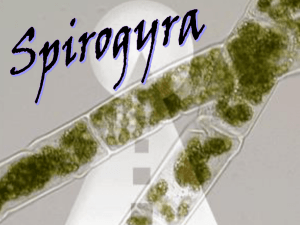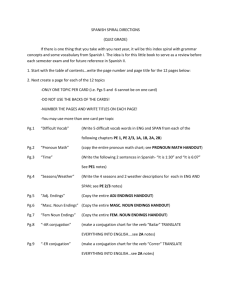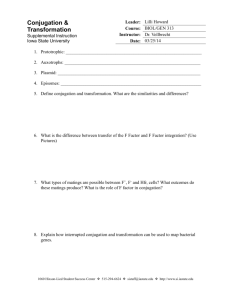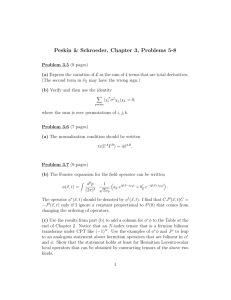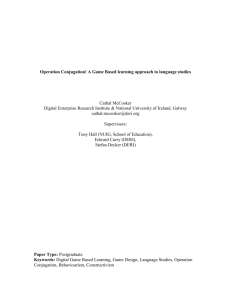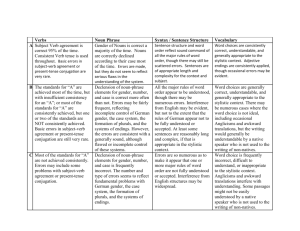spyrogyra - Sakshieducation.com
advertisement
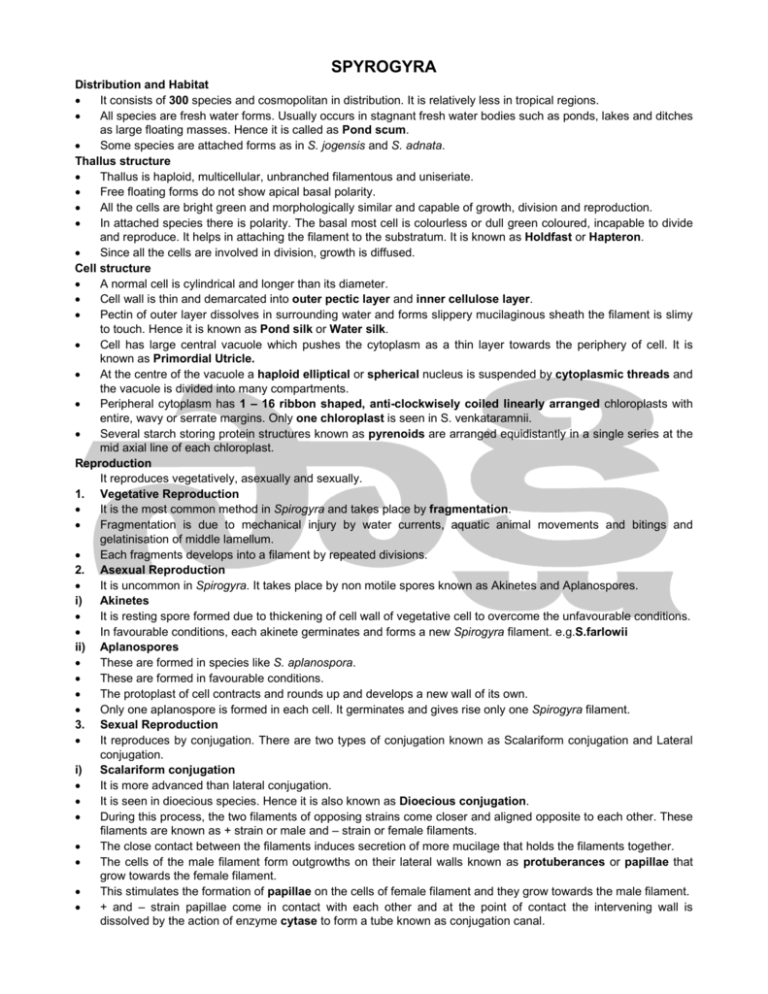
SPYROGYRA Distribution and Habitat • It consists of 300 species and cosmopolitan in distribution. It is relatively less in tropical regions. • All species are fresh water forms. Usually occurs in stagnant fresh water bodies such as ponds, lakes and ditches as large floating masses. Hence it is called as Pond scum. • Some species are attached forms as in S. jogensis and S. adnata. Thallus structure • Thallus is haploid, multicellular, unbranched filamentous and uniseriate. • Free floating forms do not show apical basal polarity. • All the cells are bright green and morphologically similar and capable of growth, division and reproduction. • In attached species there is polarity. The basal most cell is colourless or dull green coloured, incapable to divide and reproduce. It helps in attaching the filament to the substratum. It is known as Holdfast or Hapteron. • Since all the cells are involved in division, growth is diffused. Cell structure • A normal cell is cylindrical and longer than its diameter. • Cell wall is thin and demarcated into outer pectic layer and inner cellulose layer. • Pectin of outer layer dissolves in surrounding water and forms slippery mucilaginous sheath the filament is slimy to touch. Hence it is known as Pond silk or Water silk. • Cell has large central vacuole which pushes the cytoplasm as a thin layer towards the periphery of cell. It is known as Primordial Utricle. • At the centre of the vacuole a haploid elliptical or spherical nucleus is suspended by cytoplasmic threads and the vacuole is divided into many compartments. • Peripheral cytoplasm has 1 – 16 ribbon shaped, anti-clockwisely coiled linearly arranged chloroplasts with entire, wavy or serrate margins. Only one chloroplast is seen in S. venkataramnii. • Several starch storing protein structures known as pyrenoids are arranged equidistantly in a single series at the mid axial line of each chloroplast. Reproduction It reproduces vegetatively, asexually and sexually. 1. Vegetative Reproduction • It is the most common method in Spirogyra and takes place by fragmentation. • Fragmentation is due to mechanical injury by water currents, aquatic animal movements and bitings and gelatinisation of middle lamellum. • Each fragments develops into a filament by repeated divisions. 2. Asexual Reproduction • It is uncommon in Spirogyra. It takes place by non motile spores known as Akinetes and Aplanospores. i) Akinetes • It is resting spore formed due to thickening of cell wall of vegetative cell to overcome the unfavourable conditions. • In favourable conditions, each akinete germinates and forms a new Spirogyra filament. e.g.S.farlowii ii) Aplanospores • These are formed in species like S. aplanospora. • These are formed in favourable conditions. • The protoplast of cell contracts and rounds up and develops a new wall of its own. • Only one aplanospore is formed in each cell. It germinates and gives rise only one Spirogyra filament. 3. Sexual Reproduction • It reproduces by conjugation. There are two types of conjugation known as Scalariform conjugation and Lateral conjugation. i) Scalariform conjugation • It is more advanced than lateral conjugation. • It is seen in dioecious species. Hence it is also known as Dioecious conjugation. • During this process, the two filaments of opposing strains come closer and aligned opposite to each other. These filaments are known as + strain or male and – strain or female filaments. • The close contact between the filaments induces secretion of more mucilage that holds the filaments together. • The cells of the male filament form outgrowths on their lateral walls known as protuberances or papillae that grow towards the female filament. • This stimulates the formation of papillae on the cells of female filament and they grow towards the male filament. • + and – strain papillae come in contact with each other and at the point of contact the intervening wall is dissolved by the action of enzyme cytase to form a tube known as conjugation canal. • The two filaments with conjugation canals between them resemble a ladder. Hence it is known as Scalariform conjugation. • During the formation of conjugation canals, the protoplasts loose water, contract, become rounded off and transform into gametes. Each cell with a gamete in it is known as gametangium. • The +strain gamete enters into –strain cell through conjugation canal by amoeboid movement. It fuses with the –strain gamete and forms diploid zygote or zygospore. • After conjugation, the male filament is with empty cells and the female filament with zygospores. • In most of the species, the male gamete shows amoeboid movement and the female gamete is stationary. Fusion between such morphologically similar and functionally different gametes is known as Physiological anisogamy. • In few species, both types of gametes show amoeboid movement and form zygospore in the conjugation canal. Such union between morphologically and functionally similar gametes is known as Isogamy. ii) Lateral conjugation • It takes place between the cells of the same filament. • The filament possesses both male and female gametes. Hence the filament is monoecious and the conjugation is monoecious conjugation. It is of two types known as Indirect and Direct lateral conjugation. a) Indirect Lateral Conjugation • In this type papillae arise on the lateral walls of adjacent male and female cells nearer to the cross wall. • These papillae grow opposite to each other, come in contact with each other, at the point of contact the separating wall is dissolved to form a conjugation canal. • The male gamete shows amoeboid movement and enters into the female gametangium, unites with the female gamete to form diploid zygospore. • After conjugation in the filament, both empty cells and cells with zygospores are arranged in alternate manner. • It is seen in species like S. affinis. b) Direct Lateral Conjugation • It was first reported in S. jogensis by M.O.P. Iyengar. • Conjugation canals and papillae are not formed. • Usually the two cells present nearer to the holdfast are involved in this conjugation. • The cell present adjacent to the holdfast acts as female and the one above it as male. • The lower female cell swells and becomes larger and produces relatively larger female gamete. The upper cell remains small and its protoplast transforms into a male gamete with conical process. • The conical process gradually elongates and applies pressure on the cross wall separating the two cells, makes a hole in it through which it enters into the female cell by amoeboid movement, fuses with the female gamete to form diploid zygote. • Since the two gametes are morphologically and functionally different, the fusion is described as anisogamy. • Both scalariform and lateral conjugations are seen in S. gratiana Zygospore • It is usually ellipsoidal or ovoid and brown in colour. • It has three layered thick wall. The outer one is exospore or exine, middle one is mesospore or mesine and the inner one is endospore or intine. • Exospore is smooth or warty. • Food materials are stored in the form of oil globules. • Gradually the zygosporangial wall decays and the zygospore comes out and settles at the bottom of the pond. Germination of zygospore • In favourable conditions, the zygospore absorbs water and becomes active. • The diploid nucleus undergoes meiosis and forms four haploid nuclei. Three of them degenerate and only one is functional. • The zygospore with functional nucleus germinates. During this, the outer two layers of zygospore wall are ruptured, and the inner one comes out as tube like structure known as germ tube. • Germ tube is green in colour whose protoplasm has proplastids at the beginning and later converted to chloroplasts. • The green germ tube divides transversely and forms two cells. The lower cell is colourless and known as holdfast cell. This younger filament shows basal apical differentiation. • In free floating forms, the upper green cell detaches from the lower holdfast cell, floats on the surface of water, and forms the filament by repeated divisions. Parthenogenesis • Sometimes the gametes fail to fuse due to mechanical or physiological reasons. Such gametes secrete a thick wall around it and transform into resting spores known as parthenospores or azygospores. • In favourable conditions, the haploid parthenospore germinates and forms a Spirogyra filament. This formation of filaments from unfertilised gametes is known as Parthenogenesis. Life cycle • Spirogyra is haploid, multicellular plant. It reproduces vegetatively by fragmentation, asexually by akinete or aplanospore formation and sexually by conjugation. • Conjugation results in the formation of diploid zygospore. Zygospore undergoes meiosis and germinates to form haploid filament. • Life cycle of Spirogyra is described as haplontic because all the stages are haploid and diploid stage is limited to only zygospore.
